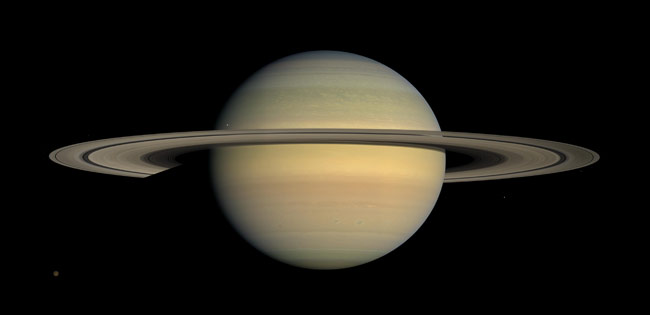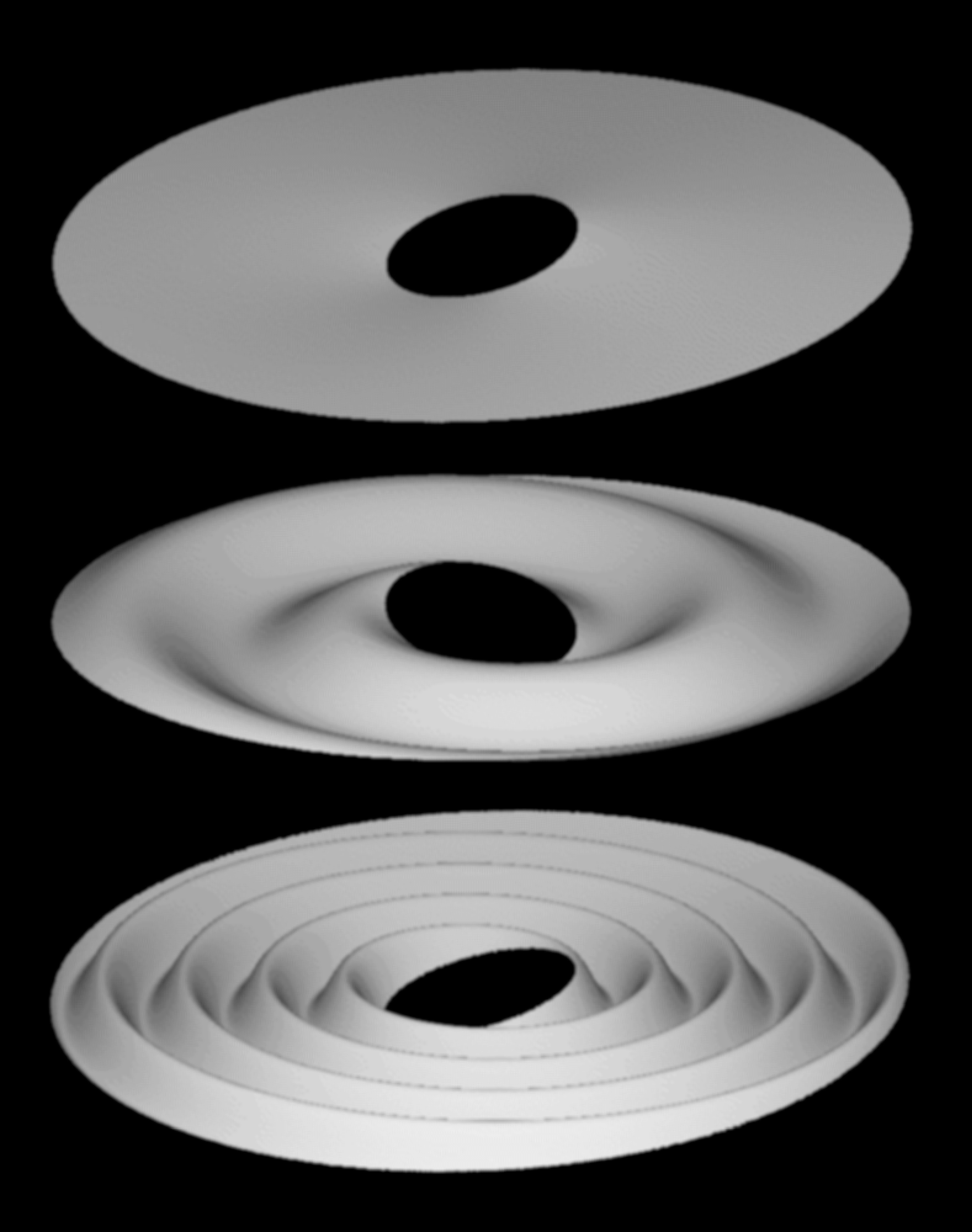
Strange formations in the rings around Saturn and Jupiter are the telltale marks of dramatic comet impacts that occurred in the last few decades, two new studies suggest.
The newly discovered ripples show that bits of a broken-up comet likely plowed through Saturn's C ring, one of many around the planet, back in 1983 — an event that went undetected by astronomers at the time. Similar structures appeared in Jupiter's gossamer rings in 1994, when the comet Shoemaker-Levy 9 slammed into that gas giant's southern hemisphere, researchers said.
The new findings show that rings can act as historical documents, chronicling the violent pasts of their parent planets, researchers said. [Photos: Jupiter Struck by Space Rock Again]
"We may have a new record of the bombardment history of the outer solar system recorded in these rings," said Matt Hedman of Cornell University, lead author of one of the studies and a co-author on the other one. "It just shows you again how rings can be useful for studying the outer solar system."
Ripples in the rings
The researchers used observations from several different NASA spacecraft to detect the ring ripples.
By poring over data and images the Cassini probe took in August 2009 — when the sun illuminated Saturn's rings edge-on — Hedman and his team noticed waves extending across the planet's entire C ring. These formations have an amplitude of 6.6 to 66 feet (2 to 20 meters), and a wavelength of 18.6 to 49.7 miles (30 to 80 kilometers), researchers said.
Get the Space.com Newsletter
Breaking space news, the latest updates on rocket launches, skywatching events and more!
In the other study, researchers led by Mark Showalter of the SETI (Search for Extraterrestrial Intelligence) Institute saw two similar patterns in Jupiter's main ring. The ripples showed up in images taken by the Galileo spacecraft in 1996 and 2000, and by the New Horizons probe in 2007.
After characterizing and analyzing the waves, the researchers determined that they formed after the rings of the two giant planets were knocked slightly off-kilter in the past several decades. [Gallery: The Rings and Moons of Saturn]

Over time, the intially tilted ring sheets spawned the ripples through a shearing process, as the ring particles orbited Saturn and Jupiter.
"It's just a winding spiral that gets wound up more and more tightly as time goes on, and eventually it looks like a vertical corrugation," Hedman told SPACE.com. The ripples should eventually dissipate, he added, though that may take a while — perhaps a few hundred years for the Saturn formation.
The scientists think they know how the rings got tilted in the first place. Clouds of broken-up comet particles likely smashed into the planets' rings in separate events, pushing the structures slightly out of whack, researchers said.
Broken-up comet crumbs
Sophisticated modeling work, along with careful study of the ripples' properties, told the researchers a lot about how and when the strange structures likely formed and evolved.
They were able to determine, for example, that the Saturn C-ring tilt probably resulted from a collision with a debris cloud with a mass between 220 billion to 22 trillion pounds (100 billion to 10 trillion kilograms). That's roughly as much material as a 0.6-mile-wide (1 km) comet contains.
And they figured out that the impact with the C ring happened in 1983, probably around August or September. Saturn's D ring became inclined at the same time (researchers noticed ripples in that structure back in 2007).
Jupiter's main ring, on the other hand, was likely tilted twice, with the most dramatic impact occurring sometime between July and October 1994.
This latter date range coincides with a famous comet smash on Jupiter — the impact of comet Shoemaker-Levy 9, which barreled into the planet from July 16 through July 20, 1994.
"If the [Jupiter] tilting event doesn't have something to do with Shoemaker-Levy 9, that would be very surprising," Hedman said.
The most parsimonious explanation is that a similar event produced Saturn's ring tilt, too, he added — especially since alternative theories aren't nearly as persuasive.
"We've considered other ideas, but thus far we haven't come up with anything that looks as plausible," Hedman said.
Big chunks of Shoemaker-Levy 9 likely didn't pass through Jupiter's main ring on their suicide path into the planet. Rather, clouds of smaller particles — formed when the planet's gravity tore the comet apart on previous passes — are likely to blame.
The same goes for the 1983 Saturn event, as well as the other, as-yet mysterious Jupiter impact that produced the main ring's secondary pattern, researchers said.
"You need a cloud that hits a broad region of the rings," Hedman said. A big solid piece would just punch holes in the rings, he added. "It won't produce the broad-scale tilt."
The researchers report their results in the April 1 issue of the journal Science.
Outer solar system's violent past
The rings of Jupiter and Saturn serve as a sort of chronicle of the bombardment history of those two giant planets, according to the new studies. The rings could help astronomers better understand how many comets may be racing around the sun.
"This could potentially provide some useful constraints on the number of small bodies running around the outer solar system," Hedman said.
The 1983 comet crash suggests that such impacts may be more common than researchers had previously believed.
"The outer solar system may be a more dynamic place than we sometimes give it credit for," Hedman said. "Maybe these events — where something crashes into the giant planets — aren't as rare as we might have originally thought."
You can follow SPACE.com senior writer Mike Wall on Twitter: @michaeldwall. Follow SPACE.com for the latest in space science and exploration news on Twitter @Spacedotcomand on Facebook.
Join our Space Forums to keep talking space on the latest missions, night sky and more! And if you have a news tip, correction or comment, let us know at: community@space.com.

Michael Wall is a Senior Space Writer with Space.com and joined the team in 2010. He primarily covers exoplanets, spaceflight and military space, but has been known to dabble in the space art beat. His book about the search for alien life, "Out There," was published on Nov. 13, 2018. Before becoming a science writer, Michael worked as a herpetologist and wildlife biologist. He has a Ph.D. in evolutionary biology from the University of Sydney, Australia, a bachelor's degree from the University of Arizona, and a graduate certificate in science writing from the University of California, Santa Cruz. To find out what his latest project is, you can follow Michael on Twitter.









